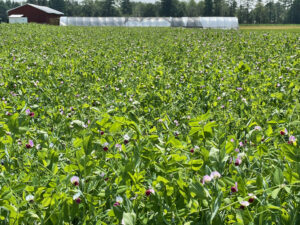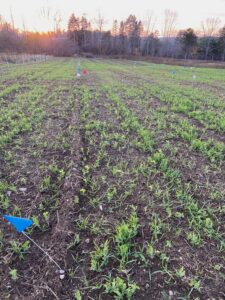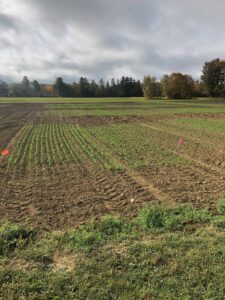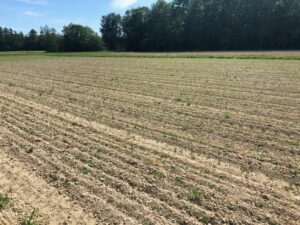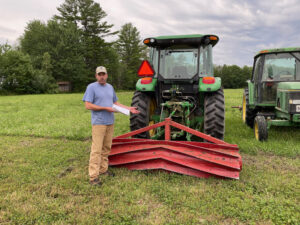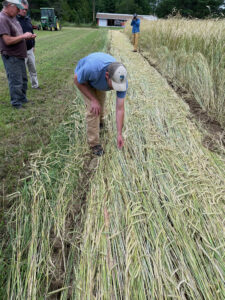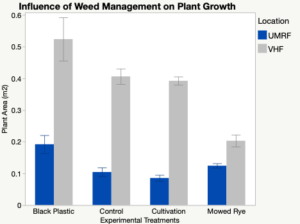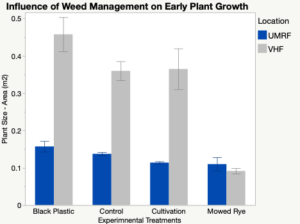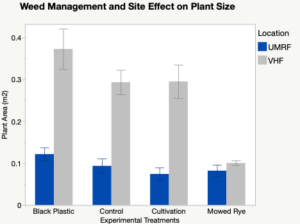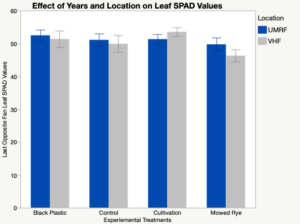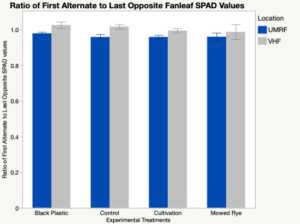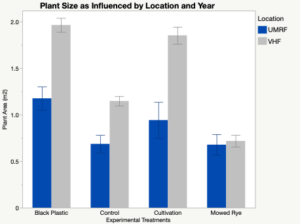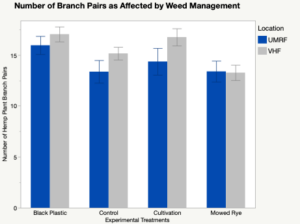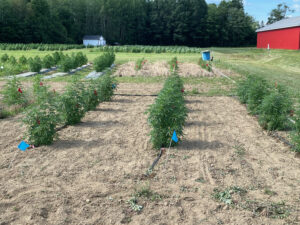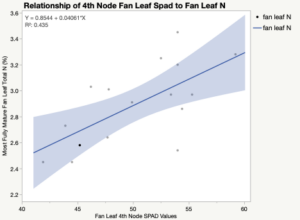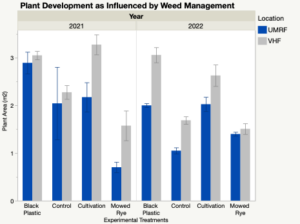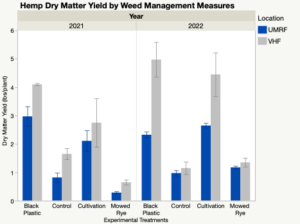Final report for ONE20-366
Project Information
After an eight-decade hiatus, hemp production is back. Farm diversity and profits can be increased if production costs can be controlled. Approximately 2625 acres have been grown in Maine since 2017. Hemp grown in the northeastern United States for cannabidiol (CBD)-rich flowers must be produced on wide (5x5) spacing to reduce disease due to high humidity. No herbicides are labeled for hemp, and with the wide spacing, there is little crop shading to slow weed growth without using plastic mulch. More than 19,000 ft2 of plastic is landfilled each year per acre of hemp produced. This waste and the fuel required to till and prepare hemp beds is unsustainable. Planting hemp into no-tilled mowed or rolled/crimped cereal rye cover crops could reduce weed pressure and reduce cost. Winter rye protects the soil from erosion, transpires water to dry soils in the spring, feeds microbes through root exudates, and inhibits weeds when rolled or mowed into a mulch. In this 2-year, 2-location project, Sarah Hewitt of Victory Hemp Farm and I evaluated CBD hemp performance in a no-till rolled/crimped or mowed rye mulch and assessed possible allelopathy or nitrogen immobilization issues. We also evaluated novel stacked cultivation tools to see if intensive cultivation can reduce weed pressure. These systems were be compared to a tilled, standard black plastic mulch production system. We assessed plant growth/development, flower and total plant yield, weed biomass, and cannabinoid content.
The project team learned a tremendous amount about resinous hemp production over the past two years. While we expected that not tilling the soil would slow down or reduce overall production, we didn’t expect the large degree of production loss in those treatments. We also learned that length of time plants are allowed to grow and genetics appear to greatly affect cannabinoid content more than plant stress caused by weed pressure. Results were be shared at grower meetings and on a hemp production website.
Through replicated research trials, we seek to explore novel means to manage weeds in CBD hemp production. We will compare a standard black plastic mulch (control treatment) to rolled/crimped winter rye, sickle-bar mowed winter rye, and stacked cultivation tools. This will be done in two experiments: one conducted with Sarah Hewitt of Victory Hemp (VHF) in Union Maine, and the other at the University of Maine Whitter Center Rogers farm (UMRF).
The project seeks to assess the effect of: 1) tillage on CBD hemp growth and development; 2) allelochemicals and nitrogen immobilization slowing plant growth and development; 3) rye cover crop destruction method (roller crimper or mowing) on continuity and thickness of cereal rye mat; 4) weed management treatments on weed density by species; and 5) weed density and plant stress on THC and CBD levels in the plant. Study results will benefit farmers by providing them with research-based information on the risks and benefits of managing weeds with rye cover crops, reducing tillage, and the effects of plant stress on the total cannabinoid content in CBD hemp.
The Farm Bills of 2014 and 2018 legalized hemp production across the US, leading to renewed farmer interest in this crop. Maine initiated its hemp licensing program in 2016, and producers have grown approximately 2500 acres of hemp, primarily for high-CBD flower, in the state over the past two years. Most farmers transplant hemp into black plastic mulch on a 5x5 or 6x6 spacing. There are no legal herbicides for use in hemp, and plastic mulch serves to both control weeds and warm the soil. However, the input costs and waste generated to produce CBD hemp in the Eastern US is not sustainable. Black plastic can only be used for one year; so, following harvest, almost 19,000 ft2 of plastic is landfilled for each acre of production. Alternative weed management systems using cover crops are needed that can produce adequate biomass to protect the soil from erosion over winter, improve soil health, slow weed germination, and make eastern hemp production competitive with our western competition.
Due to lower relative humidity, western growers don’t have to rely on plastic as they can produce hemp at increased plant densities with less concern for plant disease. Tightly spaced hemp reduces weed competition and increases flower yield per acre. Maine growers who have not used black plastic mulch have been unable to control weeds, leading to increased plant stress and lower flower yield. Maine’s hemp program director stated that poor weed control is our state’s number one hemp production issue. Along with reduced yields, CBD plants under stress can have delta-9 THC levels spike above the legal limit of 0.3%. With the new USDA interim final rule reducing the level to 0.3% total THC on a dry matter basis, more growers with stressed plants risk failing the federal THC standard. At $15,000 to $18,000 per acre production costs, a crop not meeting the THC standard is an extreme economic risk to the grower.
Possible alternatives to black plastic include plant-based cover crop mulches and timely cultivation. Planting a cereal rye cover crop in the fall would protect the soil from erosion, feed soil microflora, and when mowed or flattened/killed with a roller crimper in the spring, the rye residue will form a mulch bed through which to transplant the CBD hemp. Seed cost for a 2 bu/ac seeding is $16/ac. Not tilling the soil will also save fuel cost, labor, and carbon dioxide emissions. The University of Maine has access to a roller crimper to use for this purpose. Other farmers may not have access to this tool. Simply mowing the rye with a cycle-bar mower could be an alternative way to form a bed. We must also explore improved cultivation methods.
Research is needed to understand how CBD hemp will perform transplanted into a rye cover crop mulch. Growers need to know if hemp will be affected by either nitrogen immobilization or allelopathic chemicals that might leach out of the rye mulch. Practice using novel stacked-cultivation tools is also needed.
Cooperators
- - Producer
Research
This project supported two replicated field trials: one conducted in Union Maine on Sarah Hewitt’s VHF, and the other was conducted at the University of Maine Witter Center - Rogers Farm (UMRF) in Stillwater Maine . These were repeated in 2022. Each study was a randomized complete block study: the Union location had four treatments: black plastic mulch as the standard, sickle-bar mowed rye mulch, and cultivation and a check plot with no weed management with four replications; the UMRF location had five treatments (those previously mentioned plus a rolled/crimped rye treatment) also with four replications. Each study area was approximately 0.5 acres in size.
The project was initiated in fields with standing pea, oat, and vetch (POV) green manure cover crops.
Figure 1. Pea oat vetch (POV) cover crop at the University of Maine Rogers Farm, 2021.
In late august of both 2020 and 2021, POV cover crop biomass was sampled and then mowed and incorporated into the field. Each year the POV biomass exceeded 2.75 tons/acre on a dry matter basis (5702 lbs dm/ac in 2021; 5993 lbs dm/ac in 2022). Treatment areas were laid out and either peas and oats or Aroostook rye were broadcast sown at 2 bu/ac and rolled to ensure seed-soil contact following the model used in Mallory and Molloy (2017) at the VHF and drilled at those rates using a grain drill at the Experimental Station.
Prior to transplanting the hemp in 2021, winter rye cover crop biomass samples were taken from each plot. Yields ranged from 9212 lbs dm/ac at VHF and 8040 lbs dm/ac at UMRF; in 2022 winter rye yielded 9150 lbs dm/ac at VHF but only 6640 lbs dm/ac at UMRF due to some winter kill. This would have implications in growth and development of hemp in 2022 leading to significant statistical interactions.
Soil and experimental preparation
Dates of all research preparation and dates are provided in Table 1 and specific soil conditions in Table 2.
Table 1. Agronomic Information for Resinous Hemp Weed Control Trials – 2021/2022
|
Location |
Victory Hemp Farm |
Rogers Farm Stillwater, ME |
|
Soil Type |
Sandy loam soil 6.7% OM |
Silt loam soil 3% OM |
|
Geographic coordinates |
44.22276 , -69.2330 |
44.9297, -68.6959 |
|
Previous Crop |
Peas oats and vetch |
Peas oats and vetch |
|
Cover crop |
Winter Rye – Peas and Oats |
Winter Rye - Peas and Oats |
|
CC planting date |
2020: 9/25/2020 2021: 9/14/2021 |
2020: 9/10/2020 2021: 9/8/2021 |
|
CC planting rate (lbs/ac) |
WR – 120 / POV 260 |
WR – 120 / POV 260 |
|
Plot size |
15 ft x 25 ft |
15 ft x 25 ft |
|
Plant spacing |
5 ft x 6 ft |
5 ft x 6 ft |
|
Hemp variety |
1 month old Pasture Suver Haze |
1 month old Pasture Suver Haze |
|
Planting Date |
June 11, 2021 June 15, 2022 |
June 10, 2021 June 17, 2022 |
|
Harvest Dates – 2021 Harvest Dates – 2022 |
September 16, 21, and 23 September 15, 16 |
October 6, 7, and 8 October 5, 6, and 7 |
Table 2. Soil specific information for two experiments
|
Location |
Victory Hemp Farm |
Rogers Farm Stillwater, ME |
|
Soil pH |
6.4 / 6.5 |
6.0 / 6.2 |
|
Soil Organic Matter Content (%) |
6.0 / 6.1 |
2.7 / 2.7 |
|
Soil Phosphorus (lb/ac) |
53 / 49 |
7.7 / 8.2 |
|
Soil K (lbs/ac) |
348 lb/ac 4.3% exch 319 lb/ac 4.1% exch |
316 lbs/ac 6.0 % exch. 298 lbs/ac 5.2% exch. |
At UMRF, the winter rye plots were either sickle bar mowed or rolled/crimped. At VHF, the rye was only sickle bar mowed. At VHF, the remainder of the field was rototilled, and to establish the black plastic ‘standard’ treatment, black plastic and drip tape were laid using a bed layer. Drip tape was run down through all the plots to provide irrigation and nutrients. At UMRF, plots without a vegetative mulch were chisel plowed and disked. A bed former was also used to lay the black plastic and drip tape . The winter rye cover crop at UMRF was either mowed using a small walk behind sickle bar mower or rolled with a tractor using a 6 foot wide roller/crimper machine. The remaining treatments included a cultivated plot in which a walk behind Power Ox cultivator equipped with three sweeps was used to kill germinating weeds on a biweekly basis at both sites. The Power Ox was directed both down the length of the plot and across the plot to control the weeds biweekly in June, July and August. When hemp plants were too large to cultivate between them, that treatment was hand hoed. As well, a control plot with no weed management was used to assess the effect of intensive weed pressure on crop yield and cannabinoid content.
Figure 1b. Roller crimper used to roll down winter rye cover crops. Tom Molloy was presenting this at the 2021 field day at Stillwater Maine.
Figure 1b. Rolled winter rye cover crop.
Four-week old hemp seedlings (variety Pasture Suver Haze) that had been sufficiently hardened off were transplanted on 10 and 11-Jun at UMRF and VHF respectively in 2021, and on 15 June and 17 June 2022 at VHF and UMRF respectively. At UMRF, a slot was cut into the winter rye soil to facilitate transplanting the seedlings. At VHF the soil was sufficiently loose to allow transplanting. Each plant was hand transplanted on a 5 foot x 6 foot spacing, 15 plants per plot. The middle three plants in the middle row provided the harvest plant material for the study.
Fertigation
Irrigation intensity and timing was determined in part on rainfall and the need to apply plant nutrients. Drip lines were placed next to each plant row, with emitters every foot. Nutrients were supplied to the plant based on the farm practices. At UMRF, fertilizer was mixed to apply 8 lbs N/ac per application through a mix-rite nutrient application system. At UMRF, nutrients were applied weekly from May-July to apply 96 lbs of N prior to flowering. We increased the rate to 10 lbs N/ac in 2022. After flower initiation, nutrients were applied four more times at 5 lbs N/ac for a total of 116 lbs of N. At VHF, fertigation was effected bi-weekly using liquid nutrients (principally fish emulsion and compost teas). The nutrient content of the mixture was analyzed, and it was expected that the total application of N was approximately 42 lbs/ac less than that done at UMRF, but with the organic matter of the soil at 4% higher, less total N was needed. This is the way nutrients are typically applied based on Sarah Hewitt’s experience as a hemp grower. After the two years, whole plant total N was 2.14% and 1.94% N ... so if N was limiting, it was not a great difference.
Data Collection
To assess weed management treatment effects, plant height, diameter and node number were collected biweekly from both locations. Key sampling times were one-month after transplanting, at flower initiation and just prior to harvest. Leaf chlorophyll measurements were taken on the fan leaves at the first alternate and last opposite leaves (nodes 6 and 7) in July, and then the fan leaves four nodes from the top of the plant were measured using the SPAD meter, and also those 8 nodes from the top at flower initiation. Ratios of the first alternate to last opposite (July) and 4th and 8th nodes from the top were assessed in August at flower initiation and were correlated with fan leaf total N collected from the most fully mature fan leaf at the top of the plant at flower initiation following methods described by Cochran et al., 2019, analyzed for total N.
Harvest Methods
Harvest required collecting the middle three plants from each plot for yield assessment. For each plant harvested, the whole plant weight was recorded. The largest of the three plants was cut at the plant base approximately 10 cm above the ground surface with loppers, and the plant was weighed and separated into individual branches and run through a chipper shredder to determine whole plant dry matter, total N content, and cannabinoid content. The smallest plant of the three harvest was field weighed and air dried. The middle-sized plant was harvested, weighed and separated into individual branches and stripped of its fan leaves. Flowers were separated from individual branches using an MB1 Munch Machine bucker. Wet bud weight and unmarketable bud weight were recorded. Stems were also collected and weighed. Flower dry matter content was assessed by collecting a flower subsample and drying the flower sample overnight in a small dehydrator. Samples of the dehydrated flower were submitted for total cannabidiol (CBD) and tetrahydrocannabinol (THC) and total cannabinoid content at Nova Analytics in Portland. The percent moisture at harvest was used to calculate total dry matter and flower dry matter yields. The whole plant total N was analyzed at the University of Maine Soil Testing Lab.
Data Analysis
Using JMP 16 from SAS, data were analyzed using analysis of variance and specific contrasts to determine if weed management affected growth, weed biomass, whole plant and fan leaf total N content, whole plant yield, flower yield, and cannabinoid content. Key contrasts included the black plastic standard vs all other treatments; winter rye compared to black plastic and cultivated compared to no weed management.
Results
Environmental Conditions
The 2021 and 2022 growing seasons were one of marked extremes. Table 3 is a presentation of average temperatures, and the very low rainfall in May and June and the abnormally warm weather in June allowed an earlier than expected planting date. In 2022, we delayed planting about week at UMRF, but about 3 days later at VHF. The 2022 season was more favorable for production as it was dry for planting, and there was enough moisture through the season for growth and development, but with less moisture, there was less disease pressure, particularly at VHF.
Table 3. Average monthly temperature and rainfall collected at UMRF – 2021 and 2022
compared to 30-year averages
|
Month |
2021- Avg Monthly Temperature (C) |
2022- Avg Monthly Temperature (C) |
30-year average temperature (C) |
2021 Monthly Rainfall (mm) |
2022 Monthly Rainfall (mm) |
30-yr average rainfall (mm) |
|
Apr |
7.4 |
6.0 |
3.1 |
96 |
111 |
81 |
|
May |
12.2 |
13.1 |
12.2 |
48 |
42 |
84 |
|
June |
19.3 |
16.3 |
17.2 |
25 |
39 |
89 |
|
July |
18.1 |
21.1 |
20 |
162 |
64 |
86 |
|
Aug |
20.5 |
20.3 |
18.3 |
76 |
90 |
81 |
|
Sept |
19.5 |
14.6 |
14.4 |
216 |
144 |
96 |
|
|
|
|
|
June – Sept 479 mm (+127 mm) |
June – Sept 337 mm (-15mm) |
June – Sept 352 mm |
Early Growth and Development
Early Growth and Development
Weed management treatments led to differences in early hemp growth over both years (Figures 1a and 1b). The 2022 season was slightly more moderate and the plants coming out of the greenhouse were healthier and better hardened off to get established quickly in 2022, leading to significant year*treatment and year*location effects. The soils at the VHF farm with higher organic matter, sandy loam textures were more conducive for early growth than the Rogers Farm (UMRF) location. We found a significant treatment x location interaction caused by the apparently slower growth in 2022 at the VHF site in the mowed rye (Figure 1c). It is difficult to determine if the rye cover crop leaches out allelopathic chemicals that slow early hemp growth, if the biomass ties up N at the soil surface as microbes begin to break down the mulch, or if the lack of tillage reduces early root growth compared to the tilled soils slowing hemp production in these treatments. Given the significant treatment by location interaction, it seems like the amount of rye biomass on the soil does affect production. Given that the lack of tillage is consistent, it would seem that the winter rye could pull too much N and our fertilization was insufficient, and the reduced rye crop in 2022 could have left more N in the soil for the growing cannabis to utilize and produce larger plants, or the amount of immobilization is reduced because there is less mulch biomass to break down. The UMRF site had about 40% less cover biomass in 2022 than in 2021 due to winter kill, and the hemp in that mowed rye treatment at UMRF produced more biomass and area in 2022 than it did in 2021.
Perhaps not surprisingly, the black plastic standard created the best early season growing conditions and the plants responded accordingly. The sandy loam, high organic matter soil at VHF was significantly more conducive for early growth, and plants were almost twice as tall at VHF than at the UMRF at one-month post transplanting (Figure 1a and Figure 1b).
Figure 1a. Hemp growth at one month after transplanting - 2021
Figure 1b. Hemp growth at one month after transplanting - 2022
Figure 1c. Hemp growth at one month after transplanting averaged over years.
Plant Analysis
We used a Minolta SPAD meter to evaluate leaf color on the last opposite and first alternate fan leaf by experimental treatment one month after transplanting. Analyzing the last opposite leaf SPAD values collected across both sites with similar weed management treatments, we found that the mowed rye was significantly paler in color over both locations and years. We also found the 2022 hemp plants had significantly deeper green color compared to 2021 likely due to plants adjusting better to the transplanting in 2022.
The lowest SPAD value on the last opposite fan leaf and first alternate fan leaf was found with the mowed rye treatments at both sites (Figure 2a). This could suggest that the paler green color is due to lower N due to possible immobilization, poorer root formation due to the untilled soil, due to allelopathic chemicals leaching out of the rye causing leaf yellowing, or a combination of the three factors. We did not collect leaf tissue samples at this stage in plant development, but a later sampling would show lower leaf tissue total N in the mowed rye plots showing some immobilization occurring leading to the less deep green leaf color in those treatments over the two years.
Figure 2a. Last opposite fanleaf SPAD values as affected by weed management over 2021 and 2022 growing seasons.
The ratio of the last opposite to the first alternate SPAD values were also different at the two sites across both years. The growing conditions at VHF were more conducive to growth and development and had an average value of 1. The UMRF location's was 0.965 which probably reflected the poorer soil conditions at that location.
After using this test method in two experiments over two years, we now do not think the plants have adjusted from the transplanting or developed enough of a root system to reflect the real treatment differences at the early sampling period. The sampling done at flower initiation has shown more sensitivity to treatment differences. Unfortunately, we do not feel sampling leaf chlorophyll at a month post-transplant is an accurate test. This would be the preferred time to try to add N because the plant has another month to grow and develop before flowering, but the floral hemp plants do not exhibit deficiency well at this stage of growth. We knew that different cultivars would likely have a different starting leaf chlorophyll value due to the different shades of green found on various cannabis varieties, and as such we were hoping that the ratio of the first alternate to last opposite leaf would reflect real N status, but as one can see it did not reflect that (Figure 2b). Ratios of the first alternate branch pair fan leaf and last opposite branch pair were not sensitive to N status as hoped; there were no statistically significant differences in ratios across the weed management strategies (Figure 2b).
Figure 2b – Ratio of the first alternate to last opposite fan leaf SPAD values as affected by weed management over 2021 and 2022.
Flower Initiation – growth and development
By flower initiation, the resinous hemp plant growth had increased in size by three times at VHF and four times at UMRF over first month post-transplant plant sizes. In all cases, the VHF site had larger and more advanced plants except in the mowed rye which had a significantly greater amount of winter rye mulch material to immobilize N than the amount of winter rye which survived the ice damage at the Rogers Farm site. This led to a significant treatment by location interaction in the size of plants (Figure 3a). Where the plants were allowed to thrive with little competition, the VHF black plastic and cultivated plants were almost twice the size of those at UMRF. This speaks to the need to carefully select production sites (high organic matter, well drained soils are ideal) which characterized the VHF site. Also, due to the lack of rainfall in June and early July in Stillwater, weed growth was considerably less productive in the controls than that found at VHF. Thus, the hemp in the control plots at VHF were larger than those at UMRF, because those weeds received more natural precipitation and better competed for the resources available.
Figure 3a. Plant size as affected by weed management at flower initiation (2-months post-transplant)
Flower Initiation – Number of Branch Pairs
Along with plant area at flower initiation, weed control influenced the number of branch pairs the plants produced. One can further imagine that the number of branch pairs would affect the number of flower production sites.
In this case, the response of the plants in the number of fully developed branch pairs was similar to what we found in plant size (area) (Figure 3b). There was also a significant treatment x location interaction again caused by the mowed rye slowing growth. If weeds were controlled by plastic mulch or cultivation, the plants at both locations were larger, and they had more branch pairs.
Figure 3b. Plant node number as affected by weed management at flower initiation (2-months post transplanting).
Image #3. Height differences caused by weed management measures.
The more intensive broadleaf weed population at VHF likely limited N and affected growth more than at the UMRF location, particularly during the dry June and July periods in 2022 (Table 3). As well, plants in the mowed rye treatment were three times smaller than the black plastic at VHF while only two times smaller at UMRF. Black plastic appeared to be more useful at UMRF than at VHF. Again, the soil type was more conducive for cannabis production at VHF than UMRF, and the difference in development in the mowed rye plot was greater at VHF than UMRF.
Flower initiation – leaf SPAD
Although the fertility management was different at the two locations, leaf color was surprisingly similar across locations. To check the fertility status of cannabis plants, the CSDRE (2018) recommends sampling the fan leaf from the 4th fully developed node from the top of the plant at flower initiation. Following this model, we measured fan leaf SPAD values at the 4th most fully developed branch pair from the top of the plant. We also counted four branch pairs down from that and collected SPAD measurements at the 8th fully developed branch pair from the top. We then developed ratios of the 8th to the 4th to see if N might have been limited by weed management at either location (Table 4). Fan leaf total N was also collected at VHF in both 2021 and 2022, but due to a misunderstanding was not done at UMRF, in 2021, but was collected in 2022.
Table 4. Fan leaf SPAD values at the 4th and 8th plant nodes and the ratio to assess apparent plant health and N status.
|
Weed Management |
4th Node |
8th Node |
Ratio 8:4 |
|
Black Plastic |
56.0a |
53.5a |
0.96a |
|
Control |
50.3b |
44.6b |
0.89bc |
|
Cultivated |
57.7a |
52.6a |
0.91ab |
|
Mowed Rye |
49.2b |
42c |
0.84c |
|
|
|
|
|
|
UMRF |
54.6a |
48.7 |
0.89 |
|
VHF |
52b |
47.6 |
0.91 |
In all these cases, leaf SPAD values' response to the weed management were generally similar across locations. The 4th node leaf SPAD value reflected well the plants' response in size and node number (Figures 3a and 3b). Reducing weeds by black plastic or cultivation generally led to the largest plants and deepest green plant color. Interestingly, the fan leaf SPAD values at the 4th node correlated the most highly to the most fully mature fan leaf N content and the relationship was statistically significant (Figure 4).
Figure 4. Relationship of 4th node fan leaf to plant N status.
Harvest - Weed Biomass
Weed biomass samples were collected, dried, and weighed to assess weed management effects just prior to harvest. The black plastic weed biomass was collected from between the rows. The remainder of the samples were collected within the plot at random. The weed dry matter production is presented below in Table 5.
Generally, weed biomass was lower in 2022 than in 2021, in part due to the very dry June and July.
The biggest difference was the weed production in the mowed winter rye plots; there was much more production in 2021 than in 2022. Due to the dry weather, we were able to water the cannabis but not the weeds at large, particularly at UMRF. Only weeds growing in the drip line moisture produced well during that period. The weed management treatments led mostly to similar weed levels by treatment and location. Tilling the soil appeared to bring up more annual broadleaf weeds which when not controlled led to significantly higher biomass compared to the mowed rye which had no tillage. Despite plowing under the previous crop residue and clover remaining in the plot from the previous year, the rye residue was not sufficient by itself to keep the clover from growing through the residue and competing particularly in the first season
Table 5. Weed dry matter yield at harvest 2021 and 2022 across location.
|
|
|
|
|
|
|
Weed Management |
Annual Grass |
Annual Broadleaf |
Perennial Broadleaf |
Total Weed Biomass |
|
|
******* g/m2 ******* |
|||
|
Black Plastic |
4.5b |
15b |
40.2b |
60a |
|
Control |
40.7a |
749.2 a |
18b |
807.8c |
|
Cultivated |
3.3b |
20.6 b |
10b |
34a |
|
Mowed Rye |
11.7ab |
109.7b |
160a |
282.1b |
|
|
NS |
|
|
|
|
UMRF |
11.3 |
190 |
61.5 |
263.1 |
|
VHF |
18.8 |
257 |
53 |
328.7 |
|
|
NS |
NS |
NS |
NS |
|
2021 |
12.9 |
306a |
77.1a |
396a |
|
2022 |
17.2 |
141.2b |
37.4b |
196b |
|
|
NS |
|
|
|
|
|
Tmt*Yr*Loc *** |
Tmt*Yr** |
Tmt*Yr*Loc *** |
Tmt*Yr** |
Numbers followed by letters that are different are statistically significantly different.
Tmt signifies Treatment; Yr signifies Year; and Loc signifies Location.
Plant Size at Harvest
Cannabis plants were larger at VHF at harvest over both years due to the much more favorable soil type and high organic matter matter content (Table 2). In 2022, the mowed rye treatment at VHF had smaller plants the other weed management treatments, and the difference between the mowed rye at VHF and UMRF was less than the other treatments. This again was due to the higher amount of winter rye slowing down development at VHF relative to UMRF.
Black plastic and cultivation treatments managed weeds well, and the plants were not limited by weed pressure, allowing the plants to approach and occasionally exceed 3 m2 in size (Figure 5a).
Figure 5a. Plant area at harvest.
Harvest: Yield and Cannabinoid Content
Plant yield, whole plant N, and cannabinoid concentrations and yield are presented in Table 6. The 2022 production year was generally more favorable across all weed management measures. Dry matter yield was higher in 2022 than 2021, but there was a treatment by year interaction caused by the improved yield of the mowed rye hemp at UMRF in 2022 relative to 2021 (Figure 5b).
Figure 5b. Significant treatment x year interaction due in part to the improved mowed rye yield at UMRF in 2022.
Both whole plant and flower samples were tested for cannabinoid content and cannabinoids yield (Table 6). Weeds limited yield in plots with either no cultivation or winter rye mulch likely due to weed competition for water and nutrients. The VHF site yielded significantly higher amounts of biomass due to the improved soil conditions, more heat, and more intermittent showers in June and July than what was found at UMRF. Flower dry matter yields also mirrored whole plant yields.
Whole plant CBD (measured in mg/g) oppositely mirrored yield as the larger the plant, generally the lower the whole plant CBD concentration. What was less expected was the lack of a response of flower cannabinoid concentration by weed management. Little research has been done to evaluate plant stress on cannabinoid concentration, but it was generally assumed that the plant produced cannabinoids and terpenes as a protection against stressors like insects, drought, etc. We initially expected that intense weed pressure in the control plots would spike CBD and THC concentrations; however, these data and work recently published by Toth et al., 2020 indicated that genetics and time to harvest will influence cannabinoid content more than apparent plant stress. Analyzed separately or across years, weed pressure did not appear to influence cannabinoid concentration. The location differences in 2022 were not as strong as 2021. Plants were transplanted a week later in 2022 than was done in 2021, and the one week less vegetative production likely reduced the differences between locations. Cannabinoid yield did reflect the weed management based on its effect on whole plant or flower dry matter yield.
Table 6. Whole plant and flower dry matter yield and cannabinoid concentrations and yield as affected by weed management measures.
|
|
Plant DM Yield |
Flower DM Yield |
Total CBD (wp) |
Flower CBD |
Flower CBD yield |
Total flower THC |
Total Flower Cannabinoid Conc. |
Whole plant Total N |
|
|
kgs/plant |
g/plant |
mg/g |
mg/g |
g/pl |
mg/g |
mg/g |
percent |
|
Black Plastic |
1.63a |
434a |
50.6ab |
170 |
73.5a |
5.8 |
208 |
1.89 |
|
Control |
0.52b |
183b |
64.3a |
156 |
27.4b |
5.6 |
187 |
2.14 |
|
Cultivation |
1.35a |
391a |
37.7b |
153 |
60.4a |
5.4 |
190 |
1.99 |
|
Mowed rye |
0.4b |
173b |
59.5ab |
159 |
28.5b |
5.6 |
192 |
2.14 |
|
|
|
|
|
NS |
|
NS |
NS |
|
|
UMRF |
0.75a |
304 |
65a |
162 |
50 |
5.6 |
202a |
2.14 |
|
VHF |
1.2b |
286 |
41b |
157 |
45 |
5.5 |
186b |
1.94 |
|
|
|
NS |
|
NS |
NS |
|
|
|
|
2021 |
0.86a |
274 |
49 |
167a |
45.6 |
6.2a |
202a |
2.06 |
|
2022 |
1.07b |
316 |
56 |
152b |
49.5 |
5.0b |
187b |
2.02 |
|
|
|
NS |
NS |
|
|
|
|
|
|
stats |
Tmt*yr |
Tmt*yr*loc** |
Tmt*yr*loc** |
Yr*Lo |
Yr*Lo |
Yr*Lo |
Yr*Lo |
Yr*Tmt |
As one might expect, whole plant and flower dry matter yield generally reflected plant size differences found throughout the study.
Conclusions
The project team learned a tremendous amount about resinous hemp production over the past two years. While we expected that not tilling the soil would slow down or reduce overall production, we didn’t expect that degree of a production loss in those treatments. We also learned that the extra weed pressure apparently stressing plant yield did not influence cannabinoid content, and that length of time plants are allowed to grow and genetics appear to greatly affect cannabinoid content more than plant stress caused by weed pressure.
Education & Outreach Activities and Participation Summary
Participation Summary:
Tours were done at both the VHF farm and the Rogers Farm in both years. After our well-attended field day in 2021, we had smaller meetings in 2022 to introduce the crop to interested people and farmers. Most of the licensed farmers that attended in 2021 were among the 20 that were licensed in 2022. So, we didn’t try to have a field day just for growers in 2022. We instead tried to teach more of the public about the crop. Sarah gave people tours on three different Sunday open farm days that she held at VHF during the production season. At UMRF, we conducted tours for the Sustainable Agriculture PSE 105 class. Some 25 students spent time being led on a tour by me. We gave tours of the Rogers Farm research at Kate Garland’s gardeners’ field day. I worked with Dr. Jay Hao to sample some of the diseased plants in this work to address upcoming pathogens moving into Maine hemp production areas. Due to the reduced interest in the crop at this moment, the number of licenses, we did the best we could.
The research report will be put on the Ag and Water Quality Research Report section of the University of Maine Cooperative Extension webpage.
Lastly, this project was presented at the University of Maine In-Service Training Program in late January 2023 to 34 educators.
Learning Outcomes
At the end of the field day, all farmers participating reported that they were interested in learning more about the results of the rolled crimped rye, but they were uncertain as to whether it would be successful. This was because they heard from Dr. Gallandt at the field day that it was his experience that the mulch slows weed growth for a period of time, but more mulch needs to be added to be ultimately effective.
It turns out that Dr. Gallandt was correct. I conducted outreach at our Maine Department of Ag Trades Show presenting these project results and learned that most people were not impressed with the rye mulch system. Most everyone at that meeting and at the In-Service Training Program in Portsmouth commented that it was too bad that the system didn't work better.
Project Outcomes
My cooperator, Sarah Hewitt, used the rye mulch system for her hemp plants in 2022. I was surprised that she wanted to after the first year, but she actually wanted small plants, limited yield volume to manage, and it worked for her that year. She is not going to continue to grow hemp.
Overall, i would have to say that the best accomplishment from this work is that one doesn't gain significantly with the use of black plastic mulch. Many growers still use it, even after we discussed the project, but it controls weeds and works. They generally don't have the labor to control the weeds any other way. But they at least know that the plots where weeds were controlled yielded well and were as healthy at harvest as those with black plastic mulch.
We definitely learned a lot in this project. I think confirming the idea that plant stress does not boost cannabinoids was equally beneficial.
There can always be more to learn in the area of weed management, but i think we did a good job in this project to meet the goals we had. I really enjoyed working with Sarah Hewitt. She was a great cooperator!
